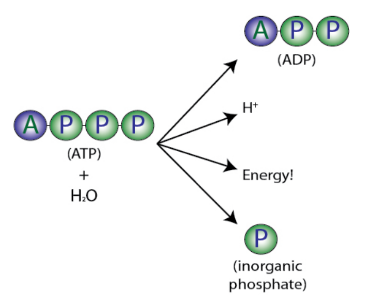Mitochondrial Biogenesis
Life begins and ends at the cellular level.
Mitochondria represent one of the most important organelles within a cell.
Mitochondria are the “powerhouse of the cell.” These organelles convert glucose, amino acids, and fatty acids from macronutrients – carbohydrates, proteins, and fats into a molecule called ATP [adenosine triphosphate]. ATP is the energy current of the cell.
It is found in significant numbers where the biomechanical processes of respiration and energy production [ATP synthesis] occur. Food represents fuel.
This energy-producing cellular powerhouse portion of your cells is responsible for 97 percent of your body’s chemical energy generated by the oxidation of organic compounds.

There are at least 400 mitochondria per cell with thousands more per cell respective to heavy hitters like your brain, liver, and muscle tissue.
Mitochondria crave proliferation to meet the increased energy demands of ultra-endurance athletes in the spirit of health, performance, and longevity.
A balance of duration and intensity in your training/exercise regimen combined with interval training improves your fitness level, and endurance sports performance while supporting the greatest adaptive mitochondrial response.
Mitochondria structures are strands from both your parents [nuclear DNA | nDNA] and a strand solely from your mother [mitochondrial DNA | mtDNA]. The mtDNA strand is particularly useful in genealogical study but a comprehensive genetic test will tell the entire story.
The myriad and breadth of differences between nDNA and mtDNA in terms of structure, composition, inheritance, recombination, number of copies, and other characteristics is beyond the scope of this article.
ENERGY SYSTEMS OF THE BODY
Energy is the capacity or potential to perform work. Endurance sports training [work] is a form of mechanical energy.
Work is performed from the hydrolysis [breakdown] of ATP which propels mechanical energy. The breakdown of food creates ATP. Remember – food is fuel. Nearly 40 percent of food ingested is converted to ATP. This mandates a well-nourished body to perform work.
When food and nutrients are consumed, they are transformed in the body into a useful source of energy through several biological processes. Each macronutrient [carbohydrates, proteins, and fats] provides various amounts of ATP.
The transformed energy is available for immediate use as ATP. The center is a sugar molecule [ribose] flanked by a string of three phosphate molecules [‘P’ in the diagram below]:

These phosphates are the key to the activity of ATP. The potential energy in the bonds holding together the sugar molecule and the phosphate groups is termed a high-energy phosphate bond. During hydrolysis [breakdown] of ATP, an enzyme catalyzes the reaction when ATP joins with water.
This energy is used to build proteins, muscle contractions, and more. This process occurs rapidly and does not require oxygen. The remaining molecule is adenosine diphosphate [ADP] because the outermost phosphate bond was split to release energy for training/work per the below diagram:

ATP is recognized as the universal energy donor because it is required by all cells in the body. ATP carries potential energy to all cells. It is the immediate energy source for muscular contraction and several metabolic processes.
The body’s energy systems are engaged at different times and amounts based on the intensity and duration of training/work. Modifications in training load [volume and intensity] dictate what, when, and how the energy system contributes to your workload.
Muscular exercise requires ATP to provide the energy needed for contraction. Metabolic pathways must exist to produce ATP.
There are three metabolic pathways used to formulate ATP:
→PCr System | Phosphagen System
Phosphocreatine [PCr] stores high-energy phosphate in the muscle proportional to muscle mass.
This pathway is anaerobic without oxygen. PCr is not a fuel source but the first energy system tapped to replenish ATP and has a lifespan of seconds. Think of intense, short-duration tasks such as sprinting, strength training, blocking in football, sprint cycling, and more.
PCr can donate a phosphate group at the ADP stage to replenish ATP until both stores have been depleted. It is at this point ATP must be generated from another metabolic pathway per the below diagram:

→Glycolysis | Lactic Acid System
The beauty of glycolysis is that it can transpire with [aerobic] or without [anaerobic] oxygen. Think of walking at a conversational pace during aerobic glycolysis.
Anaerobic glycolysis uses glucose for fuel to provide medium-short duration energy for activities that last about 30 to 120 seconds of continuous high-intensity effort. A byproduct of this system is lactic acid which has been given a bad rap. The truth is lactic acid is a viable fuel source.
Glycolysis is the metabolic pathway in which glucose is broken down into pyruvate, producing ATP molecules. The two main functions of glycolysis are to produce energy and to provide building blocks for synthesizing other needed compounds.
During glycolysis, glucose is converted into two pyruvate molecules creating a small amount of ATP and NADH [nicotinamide adenine dinucleotide + hydrogen]. NADH is synthesized in the body and is a catalyst for energy production.
→ Energy production
Energy is generated through carbohydrate stores in the muscle and liver [glycogen] to replace ATP. Glycogen first needs to be broken down to glucose.
ATP is released during the biochemical reactions of glycolysis that break down glucose molecules. This produces ATP quickly and fulfills increased cellular energy demands. Cellular needs dictate the rate of glycolysis.
→ Pyruvate production
Glycolysis breaks down glucose into two molecules of pyruvic acid, which can then be used in other reactions or enter the citric acid cycle.
Glycolysis reduces NAD+ into NADH molecules which transport electrons to the mitochondrial transport chain. These electrons help establish the gradient that drives ATP synthesis during oxidative phosphorylation.
Glycolysis occurs in the cytosol of cells and is a sequence of ten reactions catalyzed by enzymes. There is an investment phase of two ATP molecules and a payoff phase that generates the net gain of two ATP molecules
→Oxidative Phosphorylation | Aerobic System
This is an aerobic system that cannot directly produce ATP. This system converts stored energy such as glycogen, glucose, fatty acids, protein, muscle, and adipose tissue into large quantities of ATP thanks to oxygen.
This pathway sustains long-term energy for events lasting several minutes to several hours. Think of stage races, ultra-endurance events, and more.
The key to this system is fat adaptation. Each catabolized fat molecule produces 460 molecules of ATP. Each molecule of glucose produces 36 ATP molecules.
Endogenous fat provides a far greater amount of energy than glucose; yet, endurance athletes remain steadfast about fueling their bodies with insulin-spiking forms of glucose.
Catabolism of fat requires more complex metabolic pathways before ATP is produced.
One must teach its body to tap endogenous fat to sustain energy during endurance and ultra-endurance events. The tradeoff is the abundance of ATP produced versus the other metabolic pathways.
Read Life and Sport Game Changer to learn more about the concept of metabolic efficiency.
Mitochondrial biogenesis increases metabolic enzymes for glycolysis, oxidative phosphorylation, and ultimately a greater mitochondrial metabolic capacity.
The REDOX cell state may increase or decrease the number and size of mitochondria depending on the available substrates.
Mitochondrial biogenesis is critical to muscle aerobic capacity. It improves with exercise and declines via the aging process.
The vast majority of the energy needs in the human body rely on mitochondrial oxidative phosphorylation [OXPHOS].

MITOCHONDRIA AND FREE RADICALS
Mitochondria are the primary source of free radicals in cells and a by-product of ATP production when cells use oxygen to generate energy.
Free radicals are usually reactive oxygen species [ROS] and reactive nitrogen species [RNS]. Hydrogen peroxide [HO] is one free radical generated by mitochondria as an electron transfer during the respiratory chain’s auto-oxidation.
Free radicals can damage mitochondrial structure and function causing a decline in mitochondrial respiratory function and increase free radical production. Increased oxidative damage can incite inflammatory responses, stifle immune function, and promote disease.
The body produces coenzyme Q10 [CoQ10 – ubiquinone]. CoQ10 is a substance that helps convert food into energy.
CoQ10 is found in almost every cell in the body as a powerful antioxidant. Antioxidants fight free radicals intent on damaging cell membranes, and DNA while promoting cellular senescence.
CoQ10 is a natural antioxidant that neutralizes destructive free radicals, however, mitochondrial activity slows down with age and CoQ10 is decreased.
Research indicates the reduction of oxygen to generate the free radical superoxide occurs at various sites in the respiratory chain and may lead to mitochondrial dysfunction in disease states.
Mitochondria produce the energy necessary to propel the endergonic processes of cells. Mitochondria represents the most important cellular source of free radicals, the main target for free radical regulatory and toxic actions, and the source of cellular signaling.
Free radicals can be generated from numerous sources and functions in which mitochondria take the primary hits.
It is postulated the proximity of our mitochondria to the source of free radical production makes it more prone to dysfunction. Mtochondria create both what kills them and the by-products that damage cellular mechanisms.

All vital functions in your body would shut down without mitochondria. All cellular operations would cease which explains why the status of your mitochondria is critical to your health, performance, longevity, and the aging process.
Mitochondrial membranes and mtDNA are highly susceptible to oxidative damage from free radicals.
This is important because the lack of protective molecules [histones] leads to a mtDNA damage rate 20 times higher than DNA.
DNA and mitochondrial DNA (mtDNA) are used in forensic DNA identity testing. nDNA is found in the cell nucleus. mtDNA is found in the cell cytoplasm.
Oxidative stress is the burden placed on organisms by the constant production of free radicals in the normal course of metabolism. This burden causes toxic effects of peroxides and free radicals resulting in cellular damage to proteins, lipids, and signaling pathways.
Said interplay results in energy depletion, cellular instability, inflammation, tissue dysfunction, accelerated aging, chronic and degenerative diseases, and the proliferation of free radicals versus antioxidant capacity.
One of the fiercest generators of free radicals is the burning of food in the mitochondria. Free radicals thwart metabolic waste products from turning food into energy.
Toxins, infections, allergens, and nutrient-deficient foods create metabolic waste. Free radicals severely impair the ability of the cells to produce energy in the mitochondria. The ultimate loss of energy equals death.
Our body has a built-in mitochondrial protection system overwhelmed by the workload. Issues arise when we are out of balance. The system is termed REDOX because of REDuction [reduction] and OXidation [oxidation] chemical processes. REDOX concerns chemical reactions in which oxidative states have been altered.
REDOX represents a family of reactions concerned with the transfer of electrons between species. Reduction is a decrease in oxidation through the gain of electrons and oxidation is an increase in oxidation via the loss of electrons – a reversible chemical reaction in which one reaction is an oxidation and the reverse is a reduction. This ongoing cellular feud impacts mitochondrial health.
Consuming too many calories and not enough micronutrients breeds illness. The typical diet contains too many calories and anti-nutrients with an antioxidant shortfall. A balanced REDOX system and mitochondria protection are the keys to optimal health, performance, and longevity.
Anti-nutrients remain staples in the typical North American diet.
These include animal foods/protein, saturated fat, hydrogenated/trans fatty acids, cholesterol, oil, sodium, artificial sweeteners, sugar, artificial colors, monosodium glutamate/MSG, high fructose corn syrup, and hydrolyzed vegetable protein.

MITOCHONDRIAL ENERGY PRODUCTION
Mitochondria convert food and oxygen into energy via cellular respiration. Cellular respiration is the process by which biological fuels are oxidized in the presence of an inorganic electron acceptor [oxygen] to propel the creation of ATP.
Find below a simplified cellular respiration formula respective to the production of glucose via the breakdown of food:
Glucose + Oxygen = Carbon Dioxide, Water, and ATP
Water and carbon dioxide are by-products of the process. Water is expelled in our sweat, excrement, and urine while carbon dioxide is exhaled. ATP fuels all the essential functions in our cells to keep us alive and well.
ATP is a volatile compound that allows energy to travel freely and enables the release of energy when needed thanks to its instability.
Find below the basic functions of this complicated process:
→ Consumed food is broken down into carbon molecules and enters the mitochondria;
→ Carbon molecules interact with protons and electrons;
→ Protons are positive-charged and electrons are negative-charged;
→ Protons and electrons couple with oxygen molecules;
→ Protons and electrons exit the mitochondria and create ATP;
→ Mitochonfrial coupling creates byproducts of CO2, ROS, and so forth;.
→ Mitochondria may use ketones to make energy.
The basic functions are key to understanding mitochondrial uncoupling.
Mitochondrial uncoupling is any process by which electron transport is not used to generate ATP synthesis or work such as net ion translocation.
Mitochondrial uncoupling proteins play a role in physiology because the energy generates heat [thermogenesis] instead of producing ATP.
Thermogenesis is energy dissipation through heat production and occurs in specialized tissues like brown adipose tissue and skeletal muscle.
Charged particles will burst to reduce the tension. Cells will catalyze more mitochondria [mitogenesis] to accommodate couple-seeking particles via ketones, endogenous fat, and unique proteins called uncoupling proteins.
BENEFITS
Any process where electrons or protons leave the mitochondria without making ATP is called mitochondrial uncoupling. Uncoupling proteins facilitate uncoupled protons to waste calories and exit mitochondria.
Find below a few benefits of mitochondrial uncoupling:
→ Allows charged particles to leave mitochondria instead of making fuel;
→ Mitochondrial protection by regulating mitochondria particles and ROS levels;
→ Ignite thermogenesis for weight loss, vitality, optimal health, performance, and longevity;
→ Decreased ROS production;
→ Reduced mitochondrial damage;
→ Mild uncoupling can help protect mitochondrial function and reduce damage;
→ Radioresistance impacted;
→ Regulate cellular redox status, which can help protect cells from ionizing radiation;
→ Improved fiber survival;
→ Increased respiration – decreased oxygen concentration and ROS production
DISADVANTAGES
Mitochondrial uncoupling can have several disadvantages, including:
→ Decreased ATP synthesis;
→ Inhibit the formation of ATP;
→ Electron transport chain separation from ATP-synthase phosphorylation;
→ Increased respiration and temperature;
→ Energy created via respiration is released as heat;
→ Local hypoxia or ischemia;
→ Liver damage;
→ Poor water solubility and oral bioavailability;
→ Acidic shift;
→ Hyperactivation of oxidative metabolism and loss of cellular reserves;
→ Reduction of redox signaling;
→ Intracellular pO2 levels become low because of limited oxygen reserves

Nutrition is undeniably linked to mitochondrial health and linked to thermogenisis. Find below a few food groups that support mitochondrial uncoupling in the spirit of optimal health, performance, and longevity:
→ Cruciferous vegetables;
→ Leafy greens;
→ Omega-3 and omega-6 foods;
→ Nuts and seeds;
→ Grass-fed meat;
→ Wild-caught seafood;
→ Polyphenols;
→ Melatonin-rich foods
Your mitochondria change shapes and sizes to adapt to your ever-changing energy requirements via mitochondrial fission and mitochondrial fusion.
→ Mitochondrial fission
Mitochondria replicate similar to bacterial cell division. Mitochondria create several smaller mitochondria when energy demands increase.
mtDNA collaborates with the nucleus to provide the remaining protein structure to produce new mitochondria. These smaller mitochondria are more efficient and provide immediate energy to the cell.
Mitochondrial fission can be useful for regulatory control by flushing dysfunctional mitochondria from the network. Mitochondria can segregate the problematic material and expel them through fission. This process is called mitophagy [mitochondria + autophagy].
→ Mitochondrial fusion
Mitochondrial fusion is the process of igniting existing mitochondria. The mitochondrial network can power existing mitochondria by fusing with mitochondria created in fission. The existing mitochondria become longer and streamline energy production.
Find below some of the several diseases linked to mitochondrial damage.
→ Alzheimer’s disease;
→ Accelerated aging;
→ Huntington’s disease;
→ Parkinson’s disease;
→ Autism;
→ Epilepsy;
→ Cardiovascular and related diseases;
→ Chronic fatigue;
→ Fibromyalgia;
→ Diabetes;
→ Migraine headaches;
→ Neurodegenerative diseases;
→ And more
Efficient mitochondrial function is vital to optimal health, performance, and longevity in life and sport.
Increased mitochondrial size and density will bless an endurance athlete with enhanced respiratory, cardiovascular, and musculoskeletal proficiency.
Increased mitochondria and myoglobin will propel the art of energy production and the capacity for oxygen storage within the muscle.
Myoglobin is a protein that binds with oxygen in the muscle fiber. Myoglobin releases the oxygen to the mitochondria when oxygen becomes depleted during exertion.
The degree to which myoglobin content contributes to the oxidative capacity of a muscle is unclear; evidence suggests that endurance training increases myoglobin content which increases the oxygen reserve in the muscle.
→ Improved blood flow and oxygenation;
→ Reduced fatigue;
→ Increased energy production [ATP];
→ Enhanced muscle fiber interaction [elasticity | efficient contractions]:
→ Improved heart function [stroke volume | cardiac output];
→ Improved circulatory system efficiency;
→ Health at the cellular level
Maintaining an optimal number of mitochondria is key to a healthy cell. Mitochondrial dysfunction accelerates the aging process.
When your mitochondrial count is less than energy demands your mitochondria will generate the appropriate energy level.
Keep in mind that more energy production equals more free radical production. This process is amplified as we age – which is why mitochondrial dysfunction is listed as one of the Hallmarks of Aging.
MITOCHONDRIAL TRIGGERS
Protect your mitochondria and prevent rusting like a vehicle or a bowl of apple slices on the counter. One of the keys to optimal health and endurance sports performance is regeneration.
Regeneration is an ongoing process that transpires at the cellular level. The rate at which your body regenerates depends on the quality of dietary fuel to support it.
→ Exercise;
→ Nutrition;
→ Intermittent fasting;
→ Quality sleep;
→ Nicotinamide riboside;
Nicotinamide riboside (NR) and NAD-boosting supplements may support mitochondrial function. Nicotinamide riboside [vitamin B3] may increase NAD+ levels
to generate energy and maintain mitochondrial health.
Poor nutritive decisions convert the complementary stress produced by exertion into non-complementary stress. A nutrient-deficient diet and strenuous exercise will hasten cellular degeneration and accelerate aging.
Regular consumption of primary source, alkaline-forming, easily digested, absorbed, and assimilated nutrient-dense, whole foods supports cellular regeneration and optimal mitochondrial function to propel optimal health, performance, and longevity in life and sport.
A limitless life is a choice…
Click Performance Medicine™ to ignite your limitless genetic potential in life and sport.



